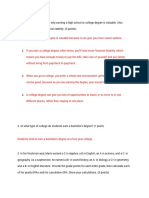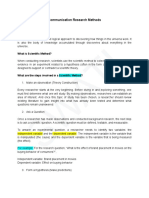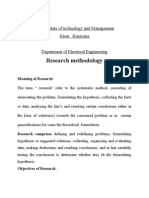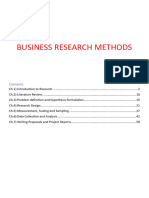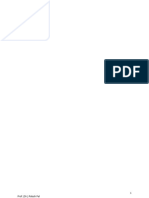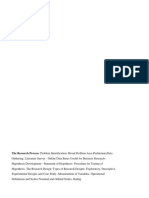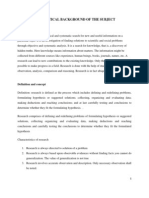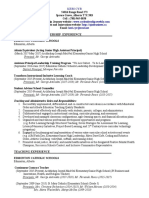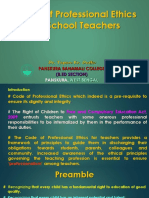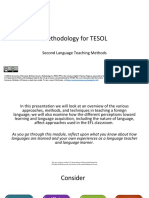Researchm
Researchm
Uploaded by
kiran121096Copyright:
Available Formats
Researchm
Researchm
Uploaded by
kiran121096Original Description:
Original Title
Copyright
Available Formats
Share this document
Did you find this document useful?
Is this content inappropriate?
Copyright:
Available Formats
Researchm
Researchm
Uploaded by
kiran121096Copyright:
Available Formats
chapter
Overview of the Research
Process
Learning Objectives
By the end of this chapter the reader will be able to:
Explain the steps in the research process.
Describe the basic components of each step.
Use the steps as an organizing mechanism for a research project.
Chapter Outline
I. Introduction
II. Definition of Research
III. Research Process
IV. Conclusion
Scientific research consists of seeing what everyone else has seen, but thinking what
no one else has thought.
Unknown
27843_CH01_Pass4.indd 1
06/07/12 12:11 AM
C hapter 1 O verview
of the
R esearch P rocess
In t ro d u c t io n
The main purpose of this chapter is to provide an overview of the research process. Many students quiver at the thought of conducting research, but, in reality,
each of us conducts research projects in our everyday lives. For example, buying a car involves the research process. The process involves collecting data to
decide between a new or used car, makes and models, and amenities; to consider
budget limitations, dealer locations, their inventory, and prices; and so on. Data
are collected and analyzed to answer the question: What type of car best meets
my needs and budget, and where is the best place to buy it? This is the research
process.
D e f i n i t i o n of R e s e arch
Research is a systematic process based on the scientific method that facilitates
the identification of relationships and determination of differences in order to
answer a question. The scientific method is a process that uses an organized structure to formulate questions and determine answers in a research project. The key
steps of scientific method are:
1. Generate a hypothesis or ask a research question. Research ideas usually start
with a vague understanding of some problem. This understanding is usually based on ones readings, observations, or other experiences in day-
to-day life. In this step, the researcher usually refines the research question
or hypothesis so that it is focused and testable.
2. Observation or data collection. The types of data and methods to collect
them are determined by the research question. Methods of data collection include surveys, questionnaires, anthropometrics, observations, and
so on.
3. Testing the hypothesis through data analysis. This step involves analyzing
the data to draw conclusions to support/refute the hypothesis or answer
the research question.
4. Conclusions. Results of the analysis are interpreted vis--vis the hypothesis
or research question.
5. Compare the results to previous established theory. The findings from the
research are compared to the established theory to determine whether or
not they fit or support the theory.
27843_CH01_Pass4.indd 2
06/07/12 12:11 AM
R e s e a r c h P r oc e s s
R e s e a r c h P r oc e s s
Regardless of the area of research or choice of methodology, the research process
involves similar activities. The process is an expression of the basic scientific method
using the following steps: statement of the problem, generating a hypothesis, review
of relevant studies, creating measures, choosing the sample, collecting data, analyzing data, and reporting results. Figure 11 illustrates the research process.
Statement of Problem
(specify and justify a problem)
Hypothesis
or
Formulating a Research Question
(precise testable statements/questions of the research problem)
Review of Literature
(collection and summary of prior relevant studies)
Measurements
(operationalization of concepts)
Sample Selection
(group of people from which data will be collected)
Data Analysis
(using statistical techniques to summarize and interpret the findings)
Figure 11 Illustration of the Research Process
27843_CH01_Pass4.indd 3
06/07/12 12:11 AM
C hapter 1 O verview
of the
R esearch P rocess
Statement of the Problem
The first step in research is pinpointing the topic of interest. Researchers usually start
out with a vague idea of some problem and then slowly try to refine this idea into a
concise statement. They review studies relevant to this topic to further illuminate the
problem and refine the research question. A strong problem statement is one supported by a thorough review of relevant study results and a strong rationale or justification for performing the study. How will this study advance the field of interest?
Generating a Hypothesis/Formulating a Research Question
Hypotheses and research questions are precise statements or questions of the research
problems. A hypothesis is a prediction of what is expected to occur, or a relationship
expected between concepts of interest. The hypothesis is typically tested with some
form of experiment. Not all studies test hypotheses. Some ask more general questions about the problem of interest. The focus can be largely descriptive.
Review of the Literature: Relevant Studies
A thorough search of literature is an important component of the research process. The review involves the collection and summary of prior studies that are relevant to the hypothesis or research question. This process assesses what is already
known about the problem and refines research questions for extending knowledge in this field. The important focus should be the determination of what this
study will add to what is already known. The review can also provide ideas of
what methods and instruments can be used to collect the data.
Measurements
Measurements are an important component of research. Individuals vary in their
interpretations of particular terms or concepts. For example, height = 60 could
mean 60 inches, or 60 centimeters. Hence, key terms in the problem statement
should be defined clearly. To follow the example of height, the researcher should
indicate that height is measured in centimeters. This process of definition is
called operationalization: The concept in the researchers head is translated into
something that can be observed, measured, and understood by others.
Sample
If the study involves human subjects, then sample means a group of people from
which data will be collected (subjects of the study). If the study is analyzing secondary data collected by another investigator, then sample refers to the data sets.
27843_CH01_Pass4.indd 4
06/07/12 12:11 AM
Further Reading
Usually the sample is a group of people representing a target population, and the
population is the larger group to whom the results are to be generalized. Types of
research bias or systematic errors can be avoided with precise definitions of the
target population and rigorous sampling strategies.
Instrumentation
Instruments are tools that collect and measure data. The selection of the tool depends
on the focus and type of research study (case study, observational study, cohort, and
so on) being conducted. Each tool that will be used to collect data should be as
precise (reliable) as possible and measure the intended concept (validity).
Data Analysis
This step in the process involves the use of statistical techniques to summarize
and interpret relevant research results. Basic descriptive statistics (i.e., measure of
incidence and prevalence, central tendency, dispersion) are part of every quantitative research study. Inferential statistics are used in studies that test hypotheses.
The main objective of data analysis is to answer the research questions or test the
hypothesis. Based on analysis results, conclusions are drawn and interpreted in
the context of previous studies.
Con c l u s i o n
This chapter illustrates research as a process of generating questions, selecting samples, and measuring, collecting, and analyzing data to answer questions. Commonly
used terms in research (e.g., statement of the problem, hypothesis, review of literature, and so on) are introduced in this chapter. The information presented in this
text is comprehensive, but not particularly detailed. Readers are encouraged to consult other sources for more details about specific procedures in the research process.
F u rt h e r R e a d i n g
Chatburn, R. L. (2011). Handbook for health care research (2nd ed.). Sudbury, MA: Jones
& Bartlett Learning.
Clark, V. L. P., & Creswell, J. W. (2010). Understanding research: A consumers guide. Upper
Saddle River, NJ: Pearson Education.
Drew, C. J., Hardman, M. L., & Hosp, J. L. (2008). Designing and conducting research in
education. Thousand Oaks, CA: Sage Publications.
McMillan, J. H. (2008). Educational research: fundamentals for the consumer (5th ed.).
Boston: Pearson Education.
27843_CH01_Pass4.indd 5
06/07/12 12:11 AM
27843_CH01_Pass4.indd 6
06/07/12 12:11 AM
You might also like
- 6.1.3 Final Exam (College and Career Prep)Document6 pages6.1.3 Final Exam (College and Career Prep)Pyper Buck100% (1)
- Solfege ExercisesDocument3 pagesSolfege Exercisesalerogxd100% (4)
- Research Methods: Simple, Short, And Straightforward Way Of Learning Methods Of ResearchFrom EverandResearch Methods: Simple, Short, And Straightforward Way Of Learning Methods Of ResearchRating: 4 out of 5 stars4/5 (13)
- Steps in Research ProcessDocument11 pagesSteps in Research ProcessImtiaz Ahmad88% (8)
- Business Research Methods NotesDocument106 pagesBusiness Research Methods NotesAce Emil100% (2)
- 1Document5 pages1Manjiro SanoNo ratings yet
- Unit 1Document68 pagesUnit 12ndbabluNo ratings yet
- ARM - Units 1 & 2Document19 pagesARM - Units 1 & 2Anonymous nDidp4No ratings yet
- What Are The Stages in The Research Process?Document3 pagesWhat Are The Stages in The Research Process?Jovz100% (1)
- Communication Research MethodsDocument7 pagesCommunication Research MethodsswatiNo ratings yet
- RRRRDocument72 pagesRRRRVenkateswara Raju100% (1)
- ResearchDocument6 pagesResearchphotocopieNo ratings yet
- Research MethodologyDocument27 pagesResearch Methodologysoumencha50% (2)
- Research MethodologyDocument73 pagesResearch MethodologyDawaNo ratings yet
- RESEARCHDocument64 pagesRESEARCHManish KumarNo ratings yet
- Business Research Definition of Research Is Given by Martyn ShuttleworthDocument4 pagesBusiness Research Definition of Research Is Given by Martyn ShuttleworthAamirNo ratings yet
- Steps of ResearchDocument2 pagesSteps of ResearchThiru PathiNo ratings yet
- Research Process - PR RESEARCHDocument4 pagesResearch Process - PR RESEARCHPratik SahaNo ratings yet
- Notes 231127 160941Document5 pagesNotes 231127 160941ndidiamakaprecious6No ratings yet
- Steps of Research ProcessDocument6 pagesSteps of Research ProcessJasreaNo ratings yet
- UNIT-1 (Source:: Research Concepts and Statement of ProblemDocument6 pagesUNIT-1 (Source:: Research Concepts and Statement of ProblemBerhanu ZelalemNo ratings yet
- Research & Research Methodology: Lecture (1) : by Asst. Prof. Dr. Fitua Al-SaediDocument8 pagesResearch & Research Methodology: Lecture (1) : by Asst. Prof. Dr. Fitua Al-SaediFahad AliNo ratings yet
- Investigatory Project 2Document4 pagesInvestigatory Project 2ronald caballesNo ratings yet
- Unit-1: Business ResearchDocument46 pagesUnit-1: Business ResearchShweta SharmaNo ratings yet
- Lesson 1 Research Methodology: Mr. Kwadwo Boateng PrempehDocument25 pagesLesson 1 Research Methodology: Mr. Kwadwo Boateng PrempehprempehNo ratings yet
- Introduction To Researcch Methods (AutoRecovered)Document61 pagesIntroduction To Researcch Methods (AutoRecovered)mikee francisco100% (1)
- Science and Research-1Document18 pagesScience and Research-1Faisal MalikNo ratings yet
- Research MethodologyDocument21 pagesResearch MethodologynithashaindrojuNo ratings yet
- CHAPTER 1 Practical Research TextbookDocument13 pagesCHAPTER 1 Practical Research TextbookBl Isaac Conde100% (1)
- Social InclusionDocument85 pagesSocial InclusionAashish BhandariNo ratings yet
- Business Research Method All in OneDocument71 pagesBusiness Research Method All in Onebibeek.1029No ratings yet
- Quantitative Research Is A Form of Research That Relies On The MethodsDocument19 pagesQuantitative Research Is A Form of Research That Relies On The MethodsRoela Marie AlbaniaNo ratings yet
- Research Methodology Assignment: Farhad Bharucha Roll No: 18 MMM Semester-1Document18 pagesResearch Methodology Assignment: Farhad Bharucha Roll No: 18 MMM Semester-1farhad10_1No ratings yet
- Module 1_Research Methodology & IPR_PPDocument13 pagesModule 1_Research Methodology & IPR_PPtrsbu96No ratings yet
- NotesDocument7 pagesNotesYashvi ThakkarNo ratings yet
- Research Methodology: An Introduction: Dr. Ekramy MokhtarDocument25 pagesResearch Methodology: An Introduction: Dr. Ekramy MokhtarAhmad Abou ZahrNo ratings yet
- Meaning of ResearchDocument11 pagesMeaning of ResearchRahulNo ratings yet
- Approach To The Research ProjectsDocument7 pagesApproach To The Research ProjectsjanineNo ratings yet
- Table of Content Research Paper Here's A Table of Contents FDocument14 pagesTable of Content Research Paper Here's A Table of Contents Fanawani18No ratings yet
- Research Methodology: 571216 Business Research Methods Unit - IDocument13 pagesResearch Methodology: 571216 Business Research Methods Unit - IDeepa DilNo ratings yet
- Research Methods NotesDocument104 pagesResearch Methods NotesMilka Mang'atiNo ratings yet
- Business Research MethodologyDocument13 pagesBusiness Research MethodologyAakash RastogiNo ratings yet
- Research Process - StepsDocument29 pagesResearch Process - StepsShaanu SaxenaNo ratings yet
- 21RMI56 Module 1 -1Document14 pages21RMI56 Module 1 -1iamstudious161No ratings yet
- Introduction To Research and Research Methods: Chapter-1Document31 pagesIntroduction To Research and Research Methods: Chapter-1Punit GuptaNo ratings yet
- Research Process BBM 502: Aditi Gandhi BBM VTH Sem. 107502Document13 pagesResearch Process BBM 502: Aditi Gandhi BBM VTH Sem. 107502geetukumari100% (1)
- Over View of Research ProcessDocument27 pagesOver View of Research ProcessBhawna JoshiNo ratings yet
- BRM ExpectedDocument13 pagesBRM ExpectedSidharth BharadwajNo ratings yet
- ResearchMethod in Mngg.Document72 pagesResearchMethod in Mngg.GuruKPONo ratings yet
- The Physician and ResearchDocument4 pagesThe Physician and ResearchJino BugnaNo ratings yet
- Shrenik's ProjectDocument26 pagesShrenik's ProjectShrenik LuniyaNo ratings yet
- GL O Bal Academy of Technology: AssignmentDocument44 pagesGL O Bal Academy of Technology: Assignmentraghuec87No ratings yet
- PR1 All in HandoutDocument28 pagesPR1 All in HandoutJahsjshdjsjckdnekfjdbhsiskNo ratings yet
- 9376 All NotesDocument73 pages9376 All Notes03189981186snNo ratings yet
- Presentation On Research DesignDocument31 pagesPresentation On Research DesigndiksangelNo ratings yet
- Unit 2 - Research ProcessDocument12 pagesUnit 2 - Research ProcessmogesNo ratings yet
- Unit I - RESEARCH METHODOLOGYDocument6 pagesUnit I - RESEARCH METHODOLOGYanitha shanuuNo ratings yet
- Introducing ResearchDocument13 pagesIntroducing Researchdeo cabradillaNo ratings yet
- Part 1: Understanding The Research Process and Getting StartedDocument10 pagesPart 1: Understanding The Research Process and Getting StartedAlia Arnz-DragonNo ratings yet
- Types of ResearchDocument6 pagesTypes of ResearchLanieGraceSandhuNo ratings yet
- PR 2 TopicsDocument9 pagesPR 2 TopicsJan Christian GarciaNo ratings yet
- Keri Cyr ResumeDocument5 pagesKeri Cyr Resumeapi-328123832No ratings yet
- IE KloekhorstPronk-2019 (Precursors)Document243 pagesIE KloekhorstPronk-2019 (Precursors)German Dziebel100% (1)
- SSSSSSBDocument8 pagesSSSSSSBArif PashaNo ratings yet
- Asking and Giving OpinionDocument9 pagesAsking and Giving Opinionade riyandinaNo ratings yet
- CHMSC EXAM 1st sem-HRM - FINAL TERMDocument3 pagesCHMSC EXAM 1st sem-HRM - FINAL TERMTitong CherazelNo ratings yet
- Iep Meeting ObservationDocument2 pagesIep Meeting Observationapi-350131256100% (1)
- Dempster-Shafer Theory Combination RuleDocument96 pagesDempster-Shafer Theory Combination RuleLidusis ArtianNo ratings yet
- Qualitative and Quantitative ResearchDocument3 pagesQualitative and Quantitative ResearchgeetuaggarwalNo ratings yet
- Assessment Development Process Topic 7Document32 pagesAssessment Development Process Topic 7Gessle GamirNo ratings yet
- CEV80309 Web Ethics and Safety Lesson PlanDocument4 pagesCEV80309 Web Ethics and Safety Lesson PlanHazel HipolitoNo ratings yet
- CommLab India How To Use ChatGPT A Guide For Instructional DesignersDocument44 pagesCommLab India How To Use ChatGPT A Guide For Instructional DesignersMagda Alejandra . CarbonellNo ratings yet
- UKG Syllabus - CBSEDocument2 pagesUKG Syllabus - CBSENiVas SankaranNo ratings yet
- Code of Professional Ethics For School TeachersDocument9 pagesCode of Professional Ethics For School TeachersDr. Tapan Kr. DuttaNo ratings yet
- (PRINTED NA) 2019chess Club ReportDocument6 pages(PRINTED NA) 2019chess Club ReportDarhil BroniolaNo ratings yet
- Test 1.2Document2 pagesTest 1.2Jaja HollaNo ratings yet
- Individualized Learning Plan Fall 2022-Heather VizziniDocument4 pagesIndividualized Learning Plan Fall 2022-Heather Vizziniapi-573010735No ratings yet
- CH 19 Change & Stress ManagementDocument28 pagesCH 19 Change & Stress Managementpappu pappa23No ratings yet
- Gorden PatternDocument7 pagesGorden PatternArsheen BalouchNo ratings yet
- Lesson Plan SampleDocument2 pagesLesson Plan SampleNancy PagliawanNo ratings yet
- Philosophy Module1Document21 pagesPhilosophy Module1Luis DaveNo ratings yet
- Prelim Physio PsychDocument28 pagesPrelim Physio PsychRM April AlonNo ratings yet
- 339-Article Text-869-3-10-20200823Document6 pages339-Article Text-869-3-10-20200823Ikram NazeerNo ratings yet
- OB Sample Exam QuestionsDocument13 pagesOB Sample Exam QuestionsSintayehu TerefeNo ratings yet
- Data AnalysisDocument28 pagesData AnalysislionlionsherNo ratings yet
- Teaching Poetry LinguisticallyDocument21 pagesTeaching Poetry LinguisticallyKhawaja Haseeb Ur RehmanNo ratings yet
- MBA7061 - Operations Management - AssignmentDocument7 pagesMBA7061 - Operations Management - Assignmentrahula.sathyapriya0% (1)
- THIS IS REAL WPS OfficeDocument5 pagesTHIS IS REAL WPS Officeqwerty69% (13)
- Methodology For TESOLDocument28 pagesMethodology For TESOLMilani MilaniNo ratings yet
